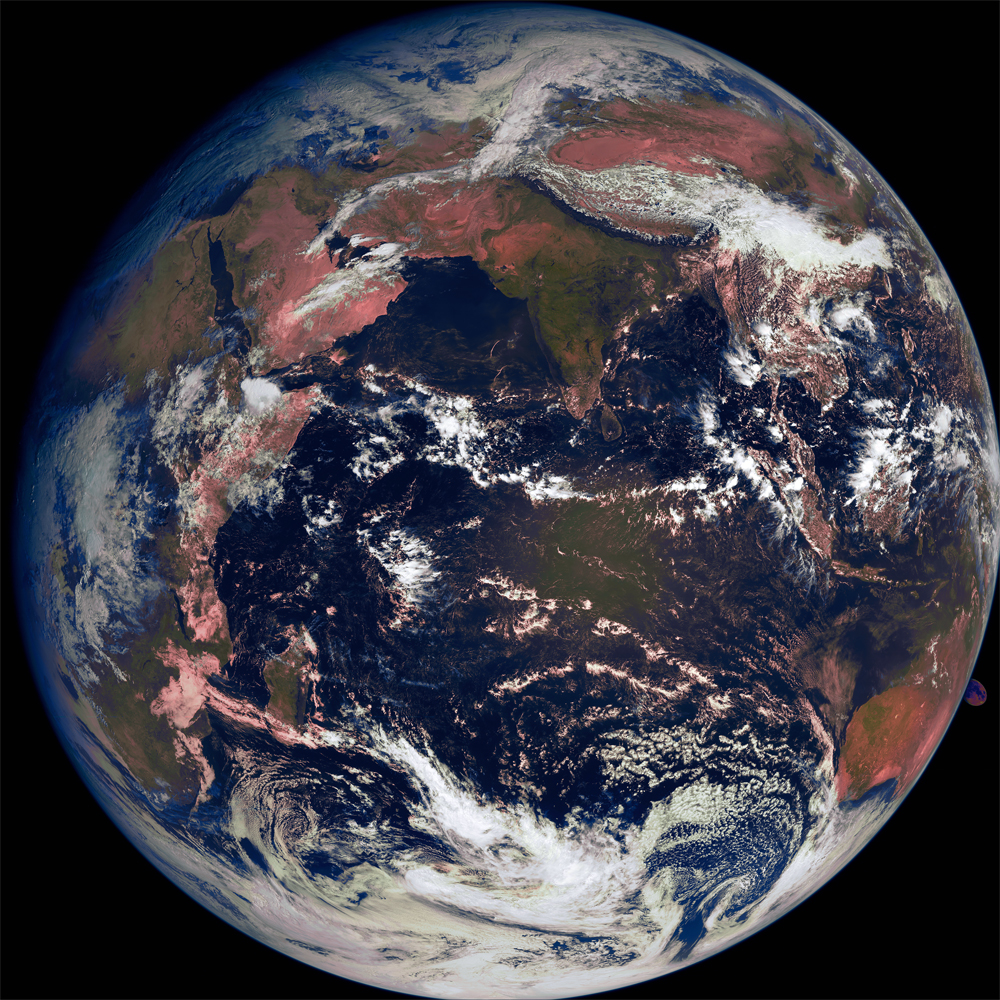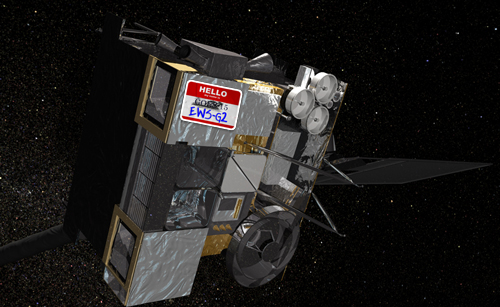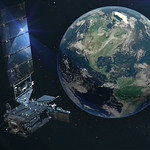![]()
Update 10/26/2023
Krzysztof Preś recently captured this image from the former GOES15 sat, currently named EWS-G2, using a Helix 1.9m dish, VLNA, BladeRF 2.0 micro aX4 and satdump as the decoding/ processing software. The sat is located over the Indian Ocean currently at EWS-G2 is 69.88E. Note in the lower SE position on the limb of the earth the moon is visible!

Space Force accepts a second weather satellite through NOAA partnership
- Published Sept. 22, 2023
- By SAF/PA Staff Writer
- Secretary of the Air Force
ARLINGTON, Va. (AFNS) —
The U.S. Space Force accepted the transfer of a second geostationary weather satellite from the National Oceanic and Atmospheric Administration to extend persistent weather coverage of the Indian Ocean region until the 2030 timeframe.
Through the Electro-optical Infrared Weather System-Geostationary mission, governed by partnership agreements between the Department of the Air Force and NOAA, the Space Force uses a residual NOAA Geostationary Operational Environmental Satellite to collect cloud imagery and perform environmental reconnaissance over the Indian Ocean region.
The partnership is a cost-effective solution, delivering mission-critical weather data to the joint force. Accurate weather data is essential for planning and execution of air, land, and maritime military operations.
“EWS-G is a prime example of innovation and the leveraging of partnerships,” said Lt Col Joseph L. Maguadog, Space System Command’s EO/IR Weather System Program Office materiel leader. “The repurposing of GOES-15 and residual NOAA ground equipment accomplished the mission at a fraction of the procurement cost of a brand-new system.”
The first EWS-G spacecraft transferred from NOAA, referred to as EWS-G1, has performed its role since September 2020. Based on remaining fuel estimates, the spacecraft is projected to reach its end of service life in February 2024.
While the Space Force is exploring long-term solutions for persistent weather coverage in the region beyond 2030, the service required a replacement to succeed EWS-G1 and asked NOAA to evaluate the possibility of transferring a second residual satellite.
After NOAA’s new GOES-18 became operational in January 2023 and congressional approval for the transfer was received in June, the Space Force accepted GOES-15 and the satellite was re-designated EWS-G2.
The second spacecraft is currently drifting towards the Indian Ocean region and will reach its assigned orbital location in November 2023.
EWS-G2 will continue to use an existing Remote Ground Station in Western Australia put in place in 2020 to support the EWS-G mission. As it currently does with EWS-G1, NOAA will operate EWS-G2 on behalf of the Space Force from the NOAA Satellite Operations Facility in Suitland, Maryland, and Wallops Command and Data Acquisition Station in Wallops Island, Virginia.
GOES-15 to become EWS-G2
Recently, Matt Seybold, GOES-R Data Ops Manager, PRO Team Lead, announced on March 15th during the Quarterly Joint GRB/HRIT/EMWIN meeting* that GOES-15 will be transferred to the United States Space Force as EWS-G2.
Update May 13, 2023 GOES-15: Currently drifting to Indian Ocean theater. Following arrival and checkout, it will become EWS-G2 (Source: NOAA NESDIS GOES DCS Spacecraft and Ground System Overview Technical Working Group, April 2023)
A brief History of GOES-15:
GOES-15 was launched atop a Delta IV-M+(4,2) rocket flying from Space Launch Complex 37B at the Cape Canaveral Air Force Station. The launch occurred at 23:57 UTC on 4 March 2010, forty minutes into a sixty-minute launch window. Upon reaching geostationary orbit on 16 March, it was redesignated GOES-15. On 6 December 2011, it was activated as the GOES-West satellite, replacing GOES-11. NOAA began to transition GOES-15 out of operational status at the GOES-West position in late 2018 to replace it with GOES-17. On March 2, 2020, GOES-15 was deactivated and moved to a storage orbit, it has been reactivated several times as a backup to GOES-17 during certain times of the year. Because of its oxidizer and fuel mass being higher than GOES-14, it became the logical choice to become EWS-G2. EWS-G2 will support GVAR Imagery only.
Similar to EWS-G1 (GOES-13), The Electro-Optical Infrared Weather System – Geostationary 2, or EWS-G2 satellite will collect cloud imagery to enable fielded forces to perform environmental reconnaissance and cloud characterization over the Indian Ocean (IO) region. For the Department of Defense, this information is critical to the preparation of operational and tactical level plans and courses of action in the IO Area of Responsibility (AOR). Data are instrumental for assessing and predicting the feasibility of certain types of air and surface missions, anticipating the effectiveness of platforms/weapons systems and munitions, determining optimal times and locations for conducting operations and evaluating logistical, survivability, protection, and quality-of-life requirements.
GOES-15 will commence drifting operations no earlier than April 2023. Lt. Col. Joseph L. Maguadog, who directs the EWS program, said Jan. 9 at the American Meteorological Society annual meeting “We’re in discussions with our NOAA partners about utilizing another GOES satellite to succeed that first capability.” Currently, the orbital position** of EWS-G2 is anticipated to be located over the Indian Ocean, perhaps as a direct replacement for EWS-G1 (GOES-13). The drift maneuver and check-out is expected to take 2-3 months.
After the relocation maneuver, NOAA and the U.S. Space Force will complete a thorough checkout of the EWS-G2 spacecraft and sensors.
A Memorandum of Agreement (MOA) dictates the cooperation on the GOES IO Relocation Plan which will transfer the GOES- 15 spacecraft to the USSF for ownership, operations, and sustainment to extend the coverage that EWS-G1 currently provides until a more long-term solution can be acquired. Satellite Control Authority (SCA) will reside with Space Delta 2 (DEL 2) and is delegated to the 19th Space Defense Squadron, Operating Location-Alpha (OL-A), located at the NSOF, for oversight of both the EWS-G1 and EWS-G2 satellite. EWS-G sustainment is provided by the USSF Space Systems Command (SSC) at Los Angeles SFB, CA.
NOAA will continue to operate EWS-G1 and EWS-G2 on the behalf of the US Space Force from the NOAA Satellite Operations Facility in Suitland, Maryland as well as the Wallops Command and Data Collection Station in Virginia.
For North and south American Coverages, GOES-17 will be the Primary backup to GOES 16 and 18; While GOES-14 will be backup to GOES-17.
For a GOES-16/18 (East/West) anomaly, GOES-17 will be activated. If it is a warm season for the GOES-17 ABI loop heat pipe anomaly, then GOES-14 will also be activated in series after GOES-17. Field users leveraging smaller antennas (~5m) will not be able to simultaneously downlink GOES-17 GRB and GOES-14 GVAR due to interference because GRB will dominate the signal.
* Link to Quarterly Joint GRB/HRIT/EMWIN meeting at bottom of that page.
** Orbital positional information will be added to this article when the exact location is released.



